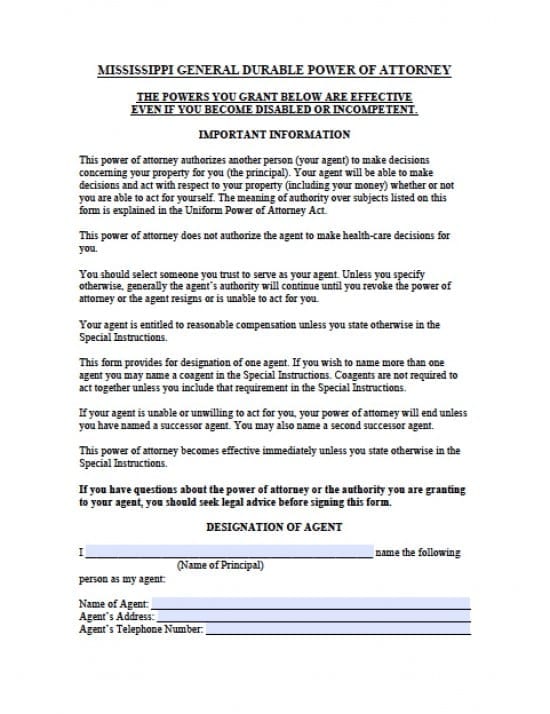 | Mississippi Durable Financial Power of Attorney Form |
The Mississippi durable financial power of attorney form is a document in which a Principal will grant an Agent, whom they trust, to oversee all of their financials including money, accounts, personal property etc. Unless otherwise stated in writing, the document will be effective immediately upon completion and notarization of the form.
Prior to completion of this form, the Principal must consider reading through the form completely to ensure they understand how the provision of this document may affect the Principal. If the language is unclear, the Principal must then consider a consultation with a knowledgeable attorney who will provide legal counsel and clarify the information before signing.
This document should be attested by witnesses or a notary, though optional. The Principal must be aware that they may revoke the document, removing powers from the Agent(s) at any time they choose, by providing written notice and delivery or service to the Agent(s)
How to Write
Step 1 – Important Information – The Principal must download the document and review the entire section of statements before proceeding
Step 2 – Designation of Agent – Enter the following:
- Enter t the name of the Principal
- AND
- Enter the name of the Agent
- The Agent’s Address
- Agent’s Telephone Number
Step 3 – Designation of Successor Agent’s – In the event the initial Agent is unwilling or unable to serve, the Principal may select up to two Successor Agent’s (Optional) – Provide the following:
- Names of Successor Agents
- Successor Agents Addresses
- Successor Agents Telephone Numbers
Step 4 – Grant of General Authority – In the fields provided, initial the fields that indicate what powers the Principal would like to allow to their Agent(s) if needed
- Real Property
- Tangible Personal Property
- Stocks and Bonds
- Commodities and Options
- Banks and Other Financial Institutions
- Operation of Entity or Business
- Insurance and Annuities
- Estates, Trusts, and Other Beneficial Interests
- Claims and Litigation
- Personal and Family Maintenance
- Benefits from Governmental Programs or Civil or Military Service
- Retirement Plans
- Taxes
- All Preceding Subjects
Step 5 – Grant of Specific Authority (Optional) -In this section there are optional powers that may be granted should the Principal decide they would like to do so. Initial the boxes that the Principal would like to grant to their Agent (The Principal should take the time to read the “Caution” information before granting these powers:
- Create, amend, revoke, or terminate an inter vivos trust
- Make a gift, subject to the limitations of the Uniform Power of Attorney Act and any special instructions in this power of attorney
- Create or change rights of survivorship
- Create or change a beneficiary designation
- Authorize another person to exercise the authority granted under this power of attorney
- Waive the principal’s right to be a beneficiary of a joint and survivor annuity, including a survivor benefit under a retirement plan
- Exercise fiduciary powers that the principal has authority to delegate
- Disclaim or refuse an interest in property, including a power of appointment
- Principal must read “Limitation On Agent’s Authority”
Step 6 – Special Instructions –
- If the Principal would like to include special instructions for their Agents” they may do so in the lines provided
Step 7 – Nomination of Conservator or Guardian – If it becomes necessary for one or more conservator(s) or Guardian to be appointed complete the following:
- Enter a name of a Nominee for conservator or guardian of the Principal’s estate if needed
- Nominee’s Address
- Nominees Telephone Number
- Read “Reliance on this POA”
Step 8 – Signatures – Should be submitted before a Notary Public:
- Enter the Principal’s Signature
- Date the signature in mm/dd/yyyy format
- Enter the Principal’s printed name
- Address
- Telephone Number
Step 9 – Notarization (highly recommended) –
- Once the Principal has provided the required information, the Notary shall complete the remaining portion of the form in acknowledgment of the information completed within the document






